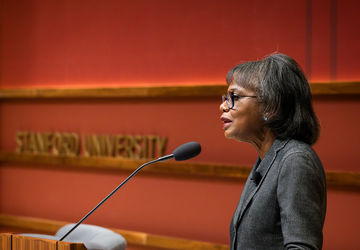Lessons in anti-violence work from male allies
A growing number of men today are advocating for feminist causes, notable among them public figures such as Canadian Prime Minister Justin Trudeau, award-winning writer Ta-Nehisi Coates and critically-acclaimed entertainer Aziz Ansari. However, as men join in the effort to promote gender equality, their experiences often involve navigating complex questions around what it means to be an ally.
Dr. Michael Messner, professor of sociology and gender studies at the University of Southern California, expands our understanding of men’s role in feminist activism. As one of the inaugural speakers for the Clayman Institute’s 18-month symposium on breaking the culture of sexual assault, Messner spoke at Stanford about both the tensions that male allies come up against and the promise their anti-violence work holds for helping end rape and domestic abuse. Messner’s talk centered around insights from his recently released book Some Men: Feminist Allies and the Movement to End Violence Against Women, in which he and coauthors Max A. Greenberg and Tal Peretz draw on life course interviews to explore the anti-violence movement and its male allies from the 1970s through the present day.
Extra criticism and extra credit
Messner pointed out a number of contradictions that come into play in men’s efforts to prevent violence against women. For example, male allies report receiving both extra criticism of their work and extra credit for it, as well. The extra criticism takes the form of greater initial scrutiny about their motives for doing anti-violence work, such as suggestions that they were doing it just to meet women. While men’s commitment to ending gender-based violence is sometimes called into question, Messner added, male allies may also face the concern that they will eventually take over and marginalize women.
On the other hand, Messner described several male allies who found themselves receiving far more attention and praise than their female colleagues for talking about the same anti-violence issues and ideas. The tendency for men’s contributions to be viewed more favorably than women’s is well documented through research. Even in the context of feminist anti-violence work, Messner noted, male privilege is “not something you take off like a pair of shoes.” This double standard can go so far that men end up getting special attention for their mere presence. One woman interviewed for the book recalled an anti-violence organization meeting in which, “they made all the men stand up and we all gave them a round of applause for being there.”
Conventional masculinity: problem, solution or both?
Another tension that surrounds the work of male allies is their relationship to conventional masculinity. Messner described how many of the well-known “rock star” men who advocate for an end to gender-based violence also embody conventional masculinity and use it to gain entree into hyper-masculine institutions such as the military. However, several of the male allies whom Messner and his coauthors interviewed “grew up as boys who could not or would not ‘measure up’ to conventional masculinity.” In their view, conventional masculinity plays a large part in creating the problem of gender-based violence; and efforts to end violence against women also go hand-in-hand with increasing respect for alternate ways of enacting masculinity. Moreover, their arguments are heard differently than those of male allies who embody traditional standards of masculinity. As a result, many male allies and the feminist women with whom they work are challenged by this traditional masculine approach to ending gender violence. Although Messner argued that each of these approaches have value, and the movement to end gender violence needs to be inclusive in order to reach its goals, these tensions prove to be a challenge in such organizing.
Connecting the dots
Throughout the past four decades of anti-violence work, activists and the general public alike have grappled with how to understand the source of gender-based violence. However, said Messner, the early male allies in the late 1970s and early 1980s who joined in the efforts to stop rape and domestic violence were primarily white, middle-class men. Though that generation viewed violence against women as fundamentally tied to the patriarchal nature of society, a younger generation of male allies is now bringing a new set of perspectives and lived experiences to anti-violence work.
Since the 1990s, more men of color have become involved in the movement, Messner explained, and they offer a new view of gender-based violence as a common link between intersecting forms of oppression. Black and Latino men from economically disadvantaged communities are drawing on their own experiences of inequality and institutionalized discrimination to frame discussions about gender-based violence as part of a broader conversation about social justice.
As we consider how men and women can to work together to promote feminist causes, there are many lessons to be learned by looking at the diverse roles that male allies have played in the ongoing efforts to end gender-based violence. Messner’s research offers a nuanced analysis of the challenges and opportunities that exist for today’s men who are engaged in this important line of work.


